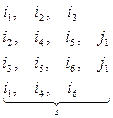
- Автоматизация
- Антропология
- Археология
- Архитектура
- Биология
- Ботаника
- Бухгалтерия
- Военная наука
- Генетика
- География
- Геология
- Демография
- Деревообработка
- Журналистика
- Зоология
- Изобретательство
- Информатика
- Искусство
- История
- Кинематография
- Компьютеризация
- Косметика
- Кулинария
- Культура
- Лексикология
- Лингвистика
- Литература
- Логика
- Маркетинг
- Математика
- Материаловедение
- Медицина
- Менеджмент
- Металлургия
- Метрология
- Механика
- Музыка
- Науковедение
- Образование
- Охрана Труда
- Педагогика
- Полиграфия
- Политология
- Право
- Предпринимательство
- Приборостроение
- Программирование
- Производство
- Промышленность
- Психология
- Радиосвязь
- Религия
- Риторика
- Социология
- Спорт
- Стандартизация
- Статистика
- Строительство
- Технологии
- Торговля
- Транспорт
- Фармакология
- Физика
- Физиология
- Философия
- Финансы
- Химия
- Хозяйство
- Черчение
- Экология
- Экономика
- Электроника
- Электротехника
- Энергетика
Topological matrices. Incidence matrices
2.2 Topological matrices
For an analytical description of electric circuit graphs and their storage in computer memory in a digital form it is more convenient to represent graphs in the form of topological matrices. There are incidence matrices (node matrices), loop matrices and graph section matrices.
2.2.1 Incidence matrices
It is said that if the node  is the end of the branch
is the end of the branch  then they are incident. Information contained in a directed graph can be fully represented by a matrix called incidence matrix (node matrix).
then they are incident. Information contained in a directed graph can be fully represented by a matrix called incidence matrix (node matrix).
The  matrix is called the incidence matrix
matrix is called the incidence matrix  which corresponds to the directed graph with “
which corresponds to the directed graph with “  ” nodes and “
” nodes and “  ” branches
” branches

 (2.1)
(2.1)
where  is the element of the
is the element of the  matrix;
matrix;
 =1 if the branch
=1 if the branch  is incident to the node
is incident to the node  and directed from the node;
and directed from the node;  =-1 if the branch
=-1 if the branch  is incident to the node
is incident to the node  and directed to the node;
and directed to the node;  =0 if the branch
=0 if the branch  is not incident to the node
is not incident to the node  . For instance, we will obtain the matrix (2.2) for the directed graph according to Fig. 2.3,c. It’s clear from the matrix that the number of non – zero elements in each line of the matrix
. For instance, we will obtain the matrix (2.2) for the directed graph according to Fig. 2.3,c. It’s clear from the matrix that the number of non – zero elements in each line of the matrix  is equal to the number of branches incident to the corresponding node. Each column contains only
is equal to the number of branches incident to the corresponding node. Each column contains only







 branches
branches
 =
= 

 (2.2)
(2.2)
incident branches
two non – zero elements: “+1” and “-1” because each branch is incident to two nodes and directed from one of them to the other. The sum of all elements of each column and, consequently, the sum of all matrix  lines is equal to zero, i.e. the matrix
lines is equal to zero, i.e. the matrix  lines are linearly dependent. Therefore, it’s possible to exclude any line of the matrix
lines are linearly dependent. Therefore, it’s possible to exclude any line of the matrix  without any information loss. So, when the 4-th line is excluded in (2.2) we get:
without any information loss. So, when the 4-th line is excluded in (2.2) we get:







 =
= 
 (2.3)
(2.3)
Matrix  is called the reduced incidence matrix.
is called the reduced incidence matrix.
|
|
|
© helpiks.su При использовании или копировании материалов прямая ссылка на сайт обязательна.
|